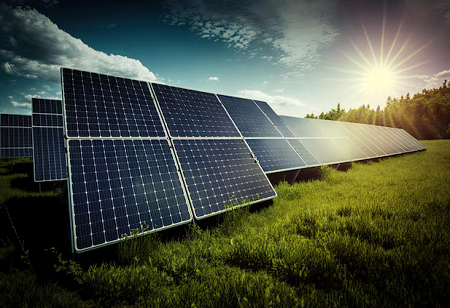
Seros Energy made a prominent appearance at the India Energy Week in February of this year, leading the way in Coal-Bed Methane (CBM) exploration in the country. The company emphasized its innovative projects and progress in the Coal-Bed Methane industry. Seros Group, Essar's business division in shipping, oil field, and well services, is the proprietor and controller of one of the biggest drilling fleets in the nation.
Seros MD & CEO Ashish Agarwal said, "Amidst a shift towards cleaner, sustainable energy sources, Seros is leading the charge for a greener, more efficient future. Our commitment to innovation and environmental responsibility isn't just a business strategy; it's a testament to our vision for shaping a sustainable energy landscape for future generations."
Hydraulics power, which is derived from the force of moving water, is at the forefront of renewable energy solutions. The versatility, reliability as well as environmental sustainability makes it one of the key players in the transaction in the cleaner energy sources. In this article let us look at the multifaceted applications of hydraulics in renewable energy generation by highlighting its importance in shaping the future of sustainable power.
Hydropower generation
Hydropower harnesses the kinetic energy of flowing water to generate electricity, and it is one of the oldest as well as one of the established forms of renewable energy. Hydraulic engineering which lies at the center of the hydropower generation comprises the design, construction as well as operation of systems which convert the energy of flowing water to electrical power.
Normally, water is stored in reservoirs formed by dams and then released through turbines, which power generators to produce electricity in traditional hydroelectric plants. Kaplan turbines, Francis Pelton, and other hydraulic turbines are crucial components of systems designed to efficiently convert the potential energy of water into mechanical energy.
Some of the factors that have resulted in the reliability, enhanced efficiency and environmental sustainability of hydropower generation include the advancements in hydraulic turbine design & technology. Streamlined flow paths, adjustable blades and advanced materials are some of the features that are incorporated by modern turbines for optimizing performance & minimizing ecological impact.
“Fueled by the imperative for decarbonization and electrification, the global energy market is undergoing a significant transformation. Businesses are increasingly endeavoring to electrify their processes and transition to sustainable energy sources,” says Nitesh Bhutada, Co-Founder, Newen Systems.
Wave & Tidal energy
The vast expanse of the oceans offers a rich source of renewable energy potential with waves as well as tides providing a continuous as well as predictable energy resource. In order to capture the kinetic energy of ocean currents, and turn them into electricity, wave and tidal energy technologies use hydraulics and tap into the massive power of the ocean for generating clean, renewable power.
Point absorbers & oscillating water columns – the wave energy converters make use of hydraulic mechanisms for harnessing the up-and-down motion of waves & they drive the generators/turbines. Tidal energy systems which include the tidal stream turbines & barrages implement hydraulics for capturing the tidal flows’ energy and convert it into rotational motion and this is then converted to electricity.
Ongoing R&D efforts are focused mostly on improving efficiency, durability as well as cost-effectiveness while wave and tidal energy technologies are in the early phases of commercialization. Furthermore, material sciences, advances in hydraulic engineering and offshore infrastructure are driving progress in these landscapes, making way for the widespread deployment of wave & tidal energy farms in coastal areas across the globe.
A combined power generation technology was patented by Researchers at the Indian Institute of Technology, Madras and this can generate electricity from tidal as well as wind sources.
Elaborating on the key aspects of this innovation, Prof. A. Seshadri Sekhar, Director, IIT Palakkad, said, "The current invention creates electricity using only one vertical axis wind turbine, a horizontal converter mechanism, and no hydraulic set generator based on pendulum support.”
Offshore wind farms
Offshore wind energy represents a rapidly growing industry in the renewable energy sector rendering vast untapped potential for clean electricity generation. Harsh marine environments as well as remote locations offer unique engineering challenges and in this landscape hydraulics plays a major role in the development & operation of offshore wind farms.
Hydraulic systems are essential for the operation as well as maintenance of offshore wind turbines and these facilitate functions which include yaw control, blade adjustment and pitch control. Hydraulic actuators are used by pitch control systems for adjusting the wind turbine blades’ angle and this helps in optimizing the orientation relative to wind direction for optimum energy capture. Hydraulic motors are used by yaw control systems for rotating the complete turbine nacelle to face into the wind, making sure of optimal performance under changing wind conditions.
Furthermore, hydraulic systems are used in offshore wind farm installation & maintenance operations comprising foundation installation, subsea cable laying and turbine servicing. Remotely Operated Vehicles as well as subsea manipulators which are the advanced hydraulic technologies facilitate precise & efficient underwater interventions reduce downtime as well as operational costs for offshore wind infrastructure.
“Wind energy has significant potential as a global clean energy source. Solar energy & wind energy sources have cost competitive with fossil fuel electricity, these are considered major factors that are driving renewable energy market growth,” says Shrenik Ghodawat, Managing Director, Renom Energy Services.
By unlocking the huge potential of air, water, and geothermal resources for powering the world sustainability, hydraulics is driving the future of renewable energy. Hydraulics enables the capture of energy and transforms it into clean electricity by decreasing the dependence on fossil fuels & mitigating the impacts of climate change.
We use cookies to ensure you get the best experience on our website. Read more...